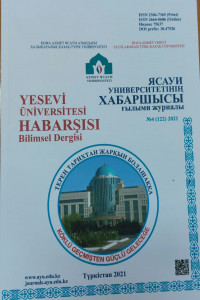About Some Animal Husbandry Terms of Turkish Origin in Nahçivan Dialects and Accents
livestock vocabulary, cattle breeding term, sheep names, goat names, inek, dana, azman, tokhlu, teke
About Some Animal Husbandry Terms of Turkish Origin in Nahçivan Dialects and Accents
livestock vocabulary, cattle breeding term, sheep names, goat names, inek, dana, azman, tokhlu, teke,
- Yayın Aralığı: Aylık
- Yayıncı: Hoca Ahmet Yesevi Uluslararası Türk-Kazak Üniversitesi
Legal Regulation of Marriage Relations
The Great Scientist of the Steppe (Abu Nasir al-Farabi – 1150)
Formation of Financial Literacy of Students through Information Technology
Zh.s. YERKİSHEVA, K.zh. NAZAROVA
Modern View on the Classification and Diagnosis of Osteoporosis (Literature Review)
B.o. SAKHOVА, G.a. SHAGİEVА, E.d. ISKANDİROVA
Normative Behavior in the Structure of Psychological Evaluation of Adolescent Behavior
T.k. BOLEYEV, D.s. ZHARKİNBAEVA, Zh.a. ABDİLAKİM
Scientific Bases of Formation of Self-consciousness of School-age Children
The Suez Canal and the Strengthening of the Positions of the European Powers in Egypt
Zh.e. TUREKULOVA, K.a. BAYTUREEVA
Historical Continuity and Features of Ethical Views in M.Kh.Dulati's Work
Zh.ye. MİRZABEKOV, Zh.a. AMİRKULOVA, T.p. MEİRBEKOV
The Concept of «Ijtihad» in Islam: Islamic Analysis
B.n. TEMİRKHANOV, T.r. BALABİYEV, L. OZTURK
THE IMPORTANCE OF SCHOOL AND FAMILY INTERACTION IN EDUCATION
